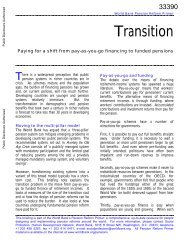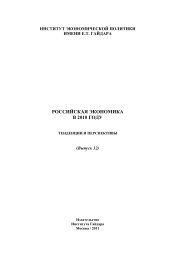Financial Sector Development in Africa: Opportunities ... - World Bank
Financial Sector Development in Africa: Opportunities ... - World Bank
Financial Sector Development in Africa: Opportunities ... - World Bank
You also want an ePaper? Increase the reach of your titles
YUMPU automatically turns print PDFs into web optimized ePapers that Google loves.
Microf<strong>in</strong>ance <strong>in</strong> <strong>Africa</strong> 27<br />
world regions—together with South Asian MFIs (20 percent), <strong>Africa</strong><br />
(21 percent) has the smallest percentage of MFIs that responded to the<br />
survey option “yet to carry out f<strong>in</strong>ancial literacy tra<strong>in</strong><strong>in</strong>g,” thus illustrat<strong>in</strong>g<br />
that at least the MFIs that took part <strong>in</strong> the survey understood the importance<br />
of f<strong>in</strong>ancial literacy and <strong>in</strong>vested <strong>in</strong> it. 17 A very large-scale example<br />
of a f<strong>in</strong>ancial literacy campaign is currently be<strong>in</strong>g carried out by the<br />
Equity Group Foundation and the MasterCard Foundation. The project<br />
is supposed to cost more than K Sh 1 billion and target women and youth<br />
<strong>in</strong> particular by engag<strong>in</strong>g 619,500 entrepreneurs over the next three years<br />
(Equity <strong>Bank</strong> 2010). By 2011, the program has already tra<strong>in</strong>ed 57,000<br />
people across Kenya (Kass Media Group).<br />
Prudential Regulation<br />
In order to <strong>in</strong>crease the variety of products to <strong>in</strong>clude sav<strong>in</strong>gs, prudential<br />
regulation has to become more viable for both the MFI and the regulator<br />
by be<strong>in</strong>g risk-based and <strong>in</strong>curr<strong>in</strong>g less costs. To ensure that the client is<br />
protected from deceptive f<strong>in</strong>ancial practices, the equilibrium between<br />
more f<strong>in</strong>ancial access and stability will have to <strong>in</strong>clude consumer protection<br />
as well. Particularly for MFI services, this has not yet been the case.<br />
Deposit-tak<strong>in</strong>g MFIs. A look at the current fund<strong>in</strong>g structure of report<strong>in</strong>g<br />
MFIs <strong>in</strong> <strong>Africa</strong> shows that deposits are the ma<strong>in</strong> contributor to fund<strong>in</strong>g<br />
(figure 1.11). Equity—both commercial and donated—rema<strong>in</strong>s small<br />
overall (21 percent for 2010). MFIs <strong>in</strong> <strong>Africa</strong>, <strong>in</strong> an <strong>in</strong>ternational comparison,<br />
have been generally successful <strong>in</strong> mobiliz<strong>in</strong>g deposits and have ma<strong>in</strong>ta<strong>in</strong>ed<br />
slightly <strong>in</strong>creas<strong>in</strong>g levels of around 60 percent as a share of total<br />
fund<strong>in</strong>g <strong>in</strong> 2010. Predom<strong>in</strong>antly, these deposits across different MFIs are<br />
voluntary deposit accounts. Accord<strong>in</strong>g to MIX and CGAP (2009), the<br />
fund<strong>in</strong>g structure composition strongly varies by organizational form.<br />
Deposits are an important fund<strong>in</strong>g base for credit unions and bank MFIs,<br />
while NGOs are a lot more dependent on borrow<strong>in</strong>g as a source of fund<strong>in</strong>g.<br />
Dur<strong>in</strong>g the f<strong>in</strong>ancial crisis, those <strong>in</strong>stitutions that relied more on<br />
deposits as their ma<strong>in</strong> fund<strong>in</strong>g source fared better (MIX and CGAP<br />
2009). A comparison between deposit-tak<strong>in</strong>g <strong>in</strong>stitutions that were able<br />
to mobilize more deposits—those with more than 20 percent voluntary<br />
sav<strong>in</strong>gs 18 —and those that were below this threshold shows that <strong>in</strong>stitutions<br />
<strong>in</strong> the first group, despite the crisis, were able to expand their number<br />
of borrowers from 12,000 to 15,500 <strong>in</strong> 2009. One reason was<br />
certa<strong>in</strong>ly the cheaper cost of funds. Another reason was the ability to offer<br />
loans at lower <strong>in</strong>terest rates: the median yield on portfolio was 11 percent







